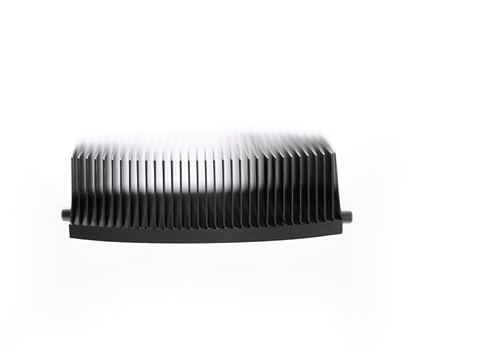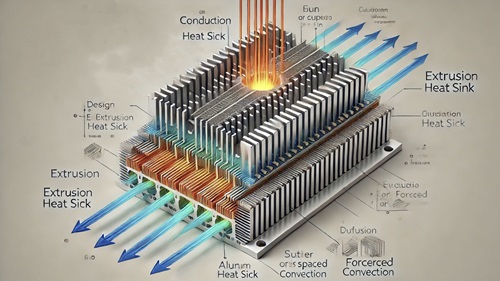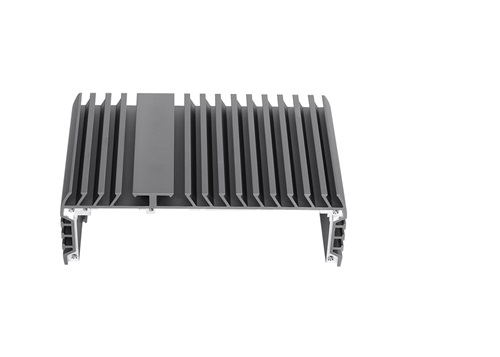In modern electronics, keeping devices cool is a fundamental requirement, not an optional design feature. Whether it's a high-performance processor, an automotive power module, or a telecom unit operating 24/7, reliable heat dissipation is essential. Among the most common heat sink types used to achieve this goal are skived heat sinks and extruded heat sinks. While both serve the same purpose, the way they work, how they are made, and the applications they suit best can be very different. Knowing these differences can save time, cost, and performance issues down the line.
Skived heat sinksare made by slicing fins directly from a solid block of metal—usually aluminum or copper—using a special blade. The cutting motion lifts thin fins upward without separating them from the base. This method forms a single-piece structure where both the base and the fins are part of the same block. No adhesives, welding, or thermal paste is needed between the base and the fins.
As heat builds up in a component, it transfers into the heat sink's base. From there, the heat flows into the fins and dissipates into the surrounding air. Because there's no interface resistance between the base and the fins, heat conduction is more efficient compared to other types of sinks that rely on secondary bonding methods.

This manufacturing process gives skived heat sinks several structural advantages. First, it allows for extremely thin fins and high fin density. You can fit more fins into a smaller space, increasing the surface area exposed to air and improving heat dissipation. Fins can also be taller than those made by many other processes, including extrusion.
Another key feature is material flexibility. Since the process works well with both aluminum and copper, designers can choose the most suitable thermal conductor for their needs. Copper offers better conductivity, while aluminum provides a balance between performance, weight, and cost.
Precision is another defining aspect. Because the cutting process is tightly controlled, each fin is uniform, the base remains flat, and dimensional tolerances are maintained. This makes skived heat sinks suitable for tightly packaged systems where space is limited but cooling demand is high.
One of the strongest advantages of skived heat sinks lies in their thermal performance. With more fins packed into a limited area, and no interface resistance between base and fin, they can efficiently transfer heat from high-wattage components. This is especially important for compact electronics, such as telecom base stations, power inverters, and compact industrial controllers.
They also shine in applications where customization matters. With no need for specialized tooling or dies, the dimensions of a skived heat sink can be adjusted relatively easily. Engineers can specify different fin heights, base thicknesses, or even special coatings without restarting the entire design process.
Finally, skived heat sinks offer a good balance between high performance and manageable production costs—especially in small- to medium-scale production where flexibility outweighs volume efficiency.
Extruded heat sinksfollow a different principle. Aluminum billets are heated until soft and then forced through a die that shapes the material into a long profile. This extrusion has a cross-section with a base and fin layout designed to suit cooling needs. After extrusion, the profiles are cut to the desired length and may be machined or finished for assembly.
When heat flows into the base of the heat sink, it spreads into the fins and is released into the air. The efficiency of this process depends on how well the base conducts heat, the size and spacing of the fins, and how much airflow is available to carry heat away from the surface.

Extruded heat sinks are widely used because the extrusion process is fast, repeatable, and well understood. The die defines the final shape, which means once the tooling is ready, thousands of identical units can be produced with very little variation.
Most extrusion is done with aluminum, which is light, corrosion-resistant, and offers good thermal conductivity. Because of the nature of the process, though, there are limits on how thin or tall the fins can be. If fins are too thin or too close together, the aluminum may not flow correctly through the die, resulting in defects.
Despite these limits, extrusion remains a practical and economical method for creating heat sinks used in everything from power supplies to lighting systems and consumer electronics.
The main benefit of extruded heat sinks is production efficiency. For large volumes, they offer low per-unit costs and consistent quality. Tooling is a one-time investment that pays off with high-volume output, making this method attractive for standardized products with long lifecycles.
They are also easy to source. Because extruded profiles follow common standards, many shapes are available off-the-shelf. This speeds up prototyping and allows designers to integrate thermal solutions quickly without waiting for custom manufacturing.
Extruded heat sinks are ideal for environments where there's enough airflow and space to accommodate standard fin spacing. They provide reliable cooling for moderate heat loads without pushing the cost or complexity envelope.

The right heat sink depends on what your system needs most: maximum thermal performance, tight integration, rapid production, or cost efficiency. Skived heat sinks offer high-density fin arrays and exceptional heat transfer efficiency, thanks to their seamless structure. They are also easier to customize for applications that demand tight tolerance or non-standard dimensions.
Extruded heat sinks, in contrast, are built for scale. They can be manufactured quickly and affordably, as long as the design remains consistent. Their simplicity makes them well-suited for consumer electronics, lighting, and other common applications that don't require ultra-compact thermal solutions.
Where skived heat sinks excel is in performance-critical environments. The high aspect ratio fins and close fin spacing give them a significant edge in removing heat under tight constraints. If you're working on a design with minimal space but significant thermal output, this option may be more suitable.
Extruded versions make more sense when the thermal load is manageable and airflow is decent. They allow for quicker sourcing and faster time to market. In cases where long-term supply and affordability matter more than performance at the thermal edge, extrusion offers the best route forward.
Comparison Table: Skived Heat Sinks vs Extruded Heat Sinks
| Feature | Skived Heat Sink | Extruded Heat Sink |
|---|---|---|
| Manufacturing Method | Precision blade cuts fins from solid metal block | Heated aluminum pushed through a shaped die |
| Fin Geometry | High density, thin, and tall fins possible | Moderate fin size and spacing due to die limitations |
| Base-Fin Connection | Seamless, single material block | Material interface between base and fins |
| Material Options | Aluminum, copper, copper alloys | Primarily aluminum only |
| Customization | Flexible, no tooling needed for shape changes | Requires new die for every profile change |
| Tooling Cost | None | High initial die cost, low per-unit cost after |
| Thermal Efficiency | Very high, minimal resistance | Moderate, with higher resistance at fin interface |
| Surface Area | Optimized through fine pitch and tall fin design | Limited by extrusion constraints |
| Production Volume | Ideal for low to mid-volume, high-performance needs | Ideal for high-volume, standardized products |
| Application Fit | Telecom, servers, EVs, power modules in tight spaces | LED lights, power supplies, general electronics |
Both skived and extruded heat sinks solve real problems. Skived models offer compact size, high thermal efficiency, and unmatched flexibility in design, while extruded sinks provide scalability, consistency, and cost control. At Enner, we manufacture both types to support a wide range of industries—from performance-critical computing to everyday electronics—ensuring that whatever your requirements are, the right cooling solution is within reach.
Need support? Reach out at[email protected]or browse our solutions atwww.ennergroup.com.
By continuing to use the site you agree to our privacy policy Terms and Conditions.